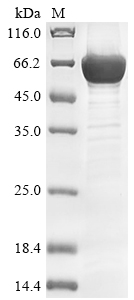Recombinant Human AP-1 complex subunit beta-1 (AP1B1) is produced in an E. coli expression system, covering the 1-584 amino acid region. This partial protein comes engineered with dual tags: an N-terminal 10xHis-tag and a C-terminal Myc-tag, which makes purification and detection more straightforward. The product reaches a purity exceeding 85%, as verified by SDS-PAGE analysis, ensuring reliable results for research applications.
AP1B1 is a subunit of the adaptor protein complex 1 (AP-1), which appears to play a critical role in mediating protein transport between the trans-Golgi network and endosomes. AP1B1 seems essential for maintaining proper protein sorting and trafficking, contributing to cellular homeostasis and molecular signaling pathways. Studying this protein is vital for understanding intracellular transport mechanisms and related cellular processes.
Potential Applications
Note: The applications listed below are based on what we know about this protein's biological functions, published research, and experience from experts in the field. However, we haven't fully tested all of these applications ourselves yet. We'd recommend running some preliminary tests first to make sure they work for your specific research goals.
Human AP1B1 is a subunit of the AP-1 adaptor complex, which requires precise folding, proper domain organization (including hinge and ear domains), and interaction with other subunits (γ, μ1, σ1) for its functional role in clathrin-coated vesicle assembly and cargo sorting. The E. coli expression system cannot provide the eukaryotic folding environment or post-translational modifications necessary for native AP1B1 structure and function. The partial fragment (1-584aa) lacks critical C-terminal regions essential for full activity, and the dual N-terminal 10xHis-tag and C-terminal Myc-tag may sterically interfere with domain folding or subunit interaction interfaces. While the protein may be soluble, the probability of correct folding with functional complex assembly activity is low.
1. Antibody Development and Validation
This application is highly suitable as antibody generation relies on linear epitope recognition. The partial fragment provides defined epitopes within the 1-584aa region, and the high purity (>85%) supports consistent immunization and screening. However, antibodies may not recognize conformational epitopes dependent on full-length folding.
2. Biochemical Characterization and Structural Studies
This protein is limited to fragment-level (1-584aa) analysis. Basic biophysical analysis can be performed, but will not reflect native AP1B1 properties. Techniques like circular dichroism or size-exclusion chromatography may assess fragment stability and aggregation, but cannot validate functional domain organization. The tags may dominate structural signals.
Final Recommendation & Action Plan
This partial AP1B1 fragment (1-584aa) expressed in E. coli with dual tags is unsuitable for functional studies requiring native complex assembly or interactions. It may be used for antibody development and limited biophysical characterization, but results must be interpreted with caution. For reliable AP1B1 research, use full-length protein expressed in eukaryotic systems to ensure proper folding and post-translational modifications.






